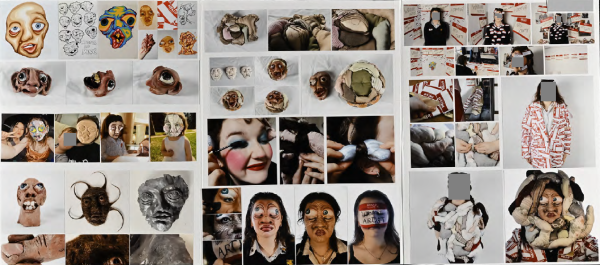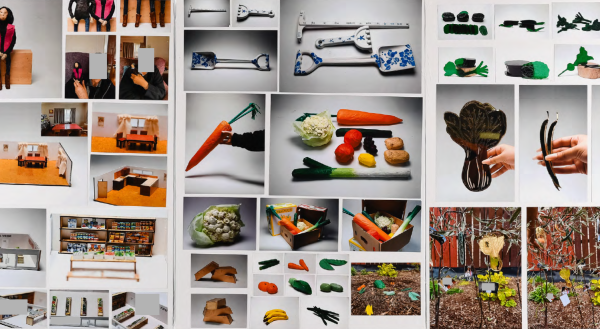2024 Scholarship
This submission presents an investigation into the identity of “the artist” and the candidate’s recurring experience of imposter syndrome. After initial research questions, the candidate asserts that many creatives face this issue, and that this is something that they would like to address in their sculptural investigation. The candidate logically uses their own body and augmented face as the central device in which to communicate ideas of construction of self and persona. They deploy a wide range of sculptural modes of practice strategically and recognise successful modes to present ideas of aspiration to becoming an artist and the anxiety that comes with that assertion. The body of work is a mechanism to affirming the belief that they are an artist.
At the beginning of the workbook, the candidate describes the work as a “love letter to selfexpression”. It is, in a way, a sculptural investigation of what it means to be an artist. The candidate has presented an honest, self-reflective commentary that underpins the sculptural work “I want this work to remind me of why I love creating”. The initial defining of the submission’s proposition is further clarified when the candidate confronts their own deferral of self-respect to those artists they admire. In this sense, the work is also a self-affirmation of creative worth.
The submission then logically starts with drawings of the artist’s face as distorted caricatures that initiate the construction of the artist’s identity or persona. These drawings successfully show disproportionate features with exaggerated expressions that allude to self-doubt and a distorted sense of self. These self-portraits test out methodologies in small, efficient drawing methods including colour pencil, collage, clay construction, and a small sculptural face that is made from the hair of the candidate. The hair self-portrait is a great example of material as
metaphor, referencing artists like Marc Quinn and Robert Gober. Gober also influences the candidate in the way in which they choose to photo-document their work. These initial works are photographed in a way that is cognisant of the role that documentation plays in the reading of sculptural work.
These simple drawing methods also allow the candidate to move quickly through ideas, so they can define their next steps with clarity and ambition. Astutely, the candidate recognises the potential of repurposing introduction labels commonly used at formal group gatherings (e.g. conferences), allowing people to introduce themselves in written form and so avoid the potentially awkward question, “What is your name?” The candidate exploits these labels, using the phrase "Hello my name is ….” to create multiple personas or layers of the same persona through text and performance.
An introduction label is used at the start of each page of the workbook starts with an introduction label, identifying different aspects of the candidates practice as an artist, e.g. “Hello, my name is… Artist trapped in a student body.”
They use this device to examine the established sculptural practice that has influenced them, introducing that page with “Hello my name is… the competition”. Logically, the final page of the workbook declares “Hello my name is… I am an Artist.”
The candidate also references their sense of self doubt in the history of self-portraiture in the workbook. They examine two famous self-portraits, suggesting the portraits show huge self-doubt. First, they analyse Rembrandt’s 1659 Self-Portrait, with a suggestion that his emotional state is clear in the facial expression of the work when considering he painted this work just after declaring bankruptcy. This analysis adds to the concern the candidate has about the financial and emotional viability of choosing to be an artist. This phase of idiosyncratic, small scale works then shifts towards larger scale performance, using both make-up and sculptural objects that augment the artist’s body in performance. The candidate successfully uses both the introduction labels in installation and as part of a suit that shows the artist wearing their anxiety on their body. This then culminates into a fantastic synthesis of faux body parts; facial make up and an anxiety label suit where the artist presents themselves as an artist with their self-doubt and distorted sense of self on full display.

Download 2024 Scholarship Sculpture workbook pages [PDF, 2 MB]
On this page
2023 Scholarship
This Scholarship Sculpture submission focuses on the candidate’s family and cultural history related to Chinese market gardening. They see their practice enquiry as an expression of their love for their grandparents and an honouring of their combined work-life and labour.
Objects and sculptural works all connect to the vegetables grown (home/market gardens) and the shop run by their Por Por (grandmother) and Gong Gong (grandfather). The candidate notes they are creating works through an imagined conception of the family fruit shop (diorama), and through stories told and photos of their grandparents at work. There is a tenderness in the rendering of these artworks that occurred in the making processes from the outset. Specific detailing that characterises the person, object, or site is technically well-executed; the scale model of the house interior diagrammatically positions the family’s social hub, and site-specific installations are made in Gong Gong’s domestic garden.
Processes employed conceptually link to family stories and Chinese market garden histories in Gisborne, where the family lived and worked. This includes the Chinese characters hand-painted onto the gardening tools representing the symbol for money (cin/yen), or Por Por and Gong Gong’s words/storytelling. This kind of embodiment of cultural linking is sophisticated. (Note: including captions on the folio to contextualise some of this information would be helpful.) Likewise, materials are treated in such a way as to connect labour and products (the hand-built papier mâché vegetables) with fortune and wealth (reflective gold acrylic perspex is used to link to histories of gold mining and the gambling game mah-jongg).
In-depth research about Chinese market gardening and immigration informs the work in productive ways alongside the stories garnered from family members. Time is spent in the workbook sharing the candidate’s family tree and ‘all of its relations’ between China and Aotearoa, market gardening and the family business, culminating in the final in-situ, family-tree installation. Having these interconnectivities revealed in this manner provides an enriched backdrop to the significance of the sculptural works and effectively maps the ‘why?’ of the project.
Time and care in the making meant the candidate could ‘tend’ to the work similarly to how their Gong Gong worked his garden. The folio artworks operate through sculptural modes of description using conventions of representation, scale, form, surface and colour. The sculpted vegetables remain faithful to both their Gong Gong's garden and real vegetables, i.e. a carrot is a carrot. Artist references make sense and provide the impetus for decisions made. Experimental phases are also well-documented in the workbook to support conceptual and directional shifts. For example, the idea to incorporate native leaves that might be found on the ground to signal the Aotearoa context; crate baskets used in China; and the gold bars. It was insightful to access this kind of thinking and decision-making process via the workbook; each of these propositions/objects had the potential to conceptualise and contextualise ideas in exciting and relevant ways.

Download 2023's Scholarship Sculpture exemplar [PDF, 5.5 MB]
2022 Scholarship
This Scholarship submission explores being a queer person and a child of first-generation immigrants. The focus is on their "experience of identifying as LGBTQIA+ whilst being raised in a Chinese household outside of China in New Zealand," described as the 'presence' of one's identity and the push-pull of different factors jostling for prominence.
The candidate states that the work was "formed by my desire for an outlet to explore and work out my own experiences and emotions." The theme is hefty and is examined through personal reflections translatable through sculptural and performative means.
In their workbook, the candidate analyses the importance of sculpture to their thinking. They understand sculpture to be unconventional or ‘lesser than’ painting in the eyes of their parents; therefore, a medium that can hold the emotional weight of the subject matter and be a "literal embodiment of failing to meet" parental expectations, potentially breaking ethical values such as "honesty, obedience, righteousness, harmony, etc."
The accompanying workbook provides insightful and intelligent oversight of the background context and research, effectively supporting the portfolio work.
The integration of methods and approaches from other artists referenced is done with sophistication. The candidate speaks of how each practice has influenced the sculptural thinking within their work, analysing how particular processes speak to their ideas. For example, the use of braille in terms of visibility and invisibility and access (Fontcuberta), and the taping of broken plates as an act of restoration (de Vries).
Symbolism is another critical strategy achieved through the incorporation of Chinese characters, and traditional, patterned material objects, fortune cookies, etc. Language is used to refer to values broken, like the newsprint banner work where the covering of the figure within the school setting is a potent comment on the place the candidate felt most comfortable expressing themselves.
The level of analysis of media, material and process to concept and context is excellent. The candidate understands how sculpture can provoke meaning conceptually through multiplicity and mass. The fortune cookies associate in this way; they refer to "an assimilation into Western culture" and "uncertainty in identity." Materially, they enact the notion of the copy, iterative process, and repetition.
The performance of walking on the cookies articulates sculptural and personal vulnerabilities, and the symbolic consequences of failure to conform. Ideas of masculinity and femininity, material symbolism, and gender are explored in Hanfu ('Straitjacket'). Made at body scale from newsprint with screen-printed patterns, the work portrays the disjuncture between the queer community they are part of and their Chinese upbringing.
The garment is well-made and, like the other works, approximates through its materiality the conflict felt. Over and over, actions that belong to sculpture are used to analyse ideas through the making processes and symbols employed.
The candidate has pursued a personally-challenging, social, ethical, political topic to create an extraordinary sculptural investigation that developed in parallel with their shifting desires, attitudes, and discoveries.

Download 2022 Scholarship Sculpture workbook pages [PDF, 21 MB]

